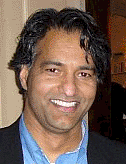 |
| |
Jason Uppal, Chief Architect, QRS (Canada) |
|

|
 Jason Uppal is a member of The Open Group’s Architecture Forum, TOGAF™ Certification Standing Committee, TOGAF Development Team and IT Architect Certification Board Members, as well as Chief Architect at QRS. Jason Uppal is a member of The Open Group’s Architecture Forum, TOGAF™ Certification Standing Committee, TOGAF Development Team and IT Architect Certification Board Members, as well as Chief Architect at QRS.
Jason Uppal, P.Eng. was the first Master IT Architect certified by The Open Group, by direct review, in October 2005. At that point, Jason had been chief architect of QR Systems Inc ( www.quickresponse.ca) for six years and had been providing senior Enterprise Architecture services. He holds an undergraduate degree in Mechanical Engineering, graduate degree in Economics and a post graduate diploma in Computer Science.
Jason’s commitment to Enterprise Architecture Life Cycle (EALC) has led him to focus on training (TOGAF), education (UOIT) and mentoring services to his clients as well as being the responsible individual for both Architecture and Portfolio & Project Management for a number of major projects.
Jason has found that education is only beneficial to those companies who can industrialize the EALC process – staff must be able to implement what they have learned. To that end, he lead a team of java software developers to develop an end to end industrialization product which encapsulates Enterprise Architecture, Portfolio and Project Management, Project Management and IT Services Management processes. Implementing this software product, ITO, (www.itoProcesses.com.) permits companies to take full advantage of TOGAF and any other custom processes which might already be in place within their organization.
|
|
|
| |
 Presentation - Stream B1 Presentation - Stream B1
Left Side of TOGAF™ - Architecting as if Implementation Matters!
Many us still struggle to define the value of Enterprise Architecture to our CFO and COO. The challenge is not that the value of EA can’t be quantified and measured, the issue is we, as architect, are unable to frame the problem that the Enterprise Architecture Practice will solve and even more importantly we have failed to accept RESPONSIBILITY for our practice.
The specific focus of this presentation will be on how to architect (right side of TOGAF) with focus on implementation and exploitation (the left side of TOGAF) in order to address the concerns of CFO and COO. This discussion is pivoted on TOGAF as a framework for EA practice, lessons from many years of hands on Enterprise Architecture initiatives and will highlight the importance of various disciplines such as Investment Portfolio Management, Program and Project Management, IT Service Management and Organization Effectiveness in Enterprise Architecture Life Cycle value chain.
Key Messages:
- Enterprise Architecture is more than just models, standards and governance; it is a practice that enables the organizations to leverage the capabilities of their People, Process and Technology assets to realize their strategic intent.
- How The Open Group Architecture Framework creates a Boundaryless Information Flow™ among disparate disciplines? Enabling an effective Enterprise Architecture Practice
- How to use TOGAF to create an Enterprise Architecture foundation to enable business strategy execution.
- Understand the contribution of and the need to engage other disciplines in order to deliver on the promised value of TOGAF.
 Presentation - Stream B2 Presentation - Stream B2
Portfolio Management – State of IT Portfolio Management and Current Challenges
In recent years, IT investment portfolio management has received a lot of attention and many organizations have spent a lot of resource trying to optimize their portfolio. One of the challenges has been how to develop credible information upon which portfolio decisions can be made. The focus of this presentation is to discuss how TOGAF framework and methods can help to define the required information to create an effective portfolio management practice.
Key Messages:
- Overview of IT Portfolio Management
- Required Information for Effective Portfolio Management at Contextual and Conceptual Level
- Portfolio Management and Execution
- Portfolio of Investment and Value Realization
 return
to program return
to program
|
|
|
|
|
|